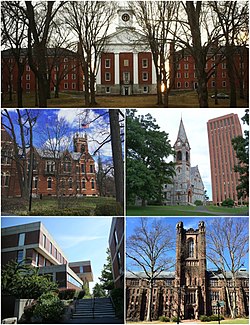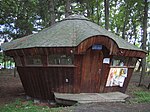Five College Consortium
The Five College Consortium (often referred to as simply the Five Colleges) comprises four liberal arts colleges and one university in the Connecticut River Pioneer Valley of Western Massachusetts: Amherst College, Hampshire College, Mount Holyoke College, Smith College, and the University of Massachusetts Amherst, totaling approximately 38,000 students.[1] They are geographically close to one another and are linked by frequent bus service that operates between the campuses during the school year.[2]
The consortium was formally established in 1965, but its roots lay in cooperative efforts between the oldest four members of the consortium dating back to 1914.[3]
History
[edit]In 1914, Massachusetts Agricultural College (now UMass), Amherst, Mount Holyoke, and Smith joined International YMCA College (now Springfield College) to form the Committee on University Extension of the Connecticut Valley Colleges, a joint continuing education program for the Pioneer Valley. In later years, Amherst, Mount Holyoke, Smith, and MAC—later known as Massachusetts State and UMass—increased their collaboration, culminating in the formation of an inter-library loaning program in 1951 and a joint astronomy department in 1959. Finally, Amherst, Mount Holyoke, Smith and UMass incorporated the Four College Consortium, which became the Five College Consortium when Hampshire College was founded in 1965, and admitted its first entering class in 1970.[3]
The five colleges operate both as independent entities as well as mutually dependent institutions. The mission of the consortium is to support long-term forms of cooperation that benefit the faculty, staff and students of the five colleges. Shared academic and cultural resources are the primary initiative of the consortium. This means that students at each of these schools are permitted and encouraged to take classes at the other colleges (through "cross-registration") at no additional cost to the student.[4] Student groups and organizations often draw participants from all five campuses and several academic programs are run by the Five Colleges (for example: astronomy, dance, some foreign languages, and women's studies[5]). The colleges also participate in an interlibrary loan program, allowing students, staff, and faculty to take advantage of all five campuses' collections.
The Five College Radio Astronomy Observatory was founded in 1969 by the Five College Astronomy Department. Together, the Five Colleges operate WFCR (Five College Radio), an NPR member station operating at 88.5 MHz in the FM band.
Bus transportation
[edit]The Pioneer Valley Transit Authority (PVTA) provides free daily intra-campus bus service to students, staff, and faculty during the school year. The buses, some of them run by University of Massachusetts Transportation Services and operated by student workers, run on a frequent schedule, allowing car-free travel to classes, social events, and local shopping areas.[6] This service is funded primarily through a contract with the member institutions.[7]
See also
[edit]- Cooperating Colleges of Greater Springfield, a local association of colleges which often collaborate with Five College institutions
- Museums10, a collaboration of several local museums run by the Five Colleges
- UMassFive College Federal Credit Union
References
[edit]- ^ "Five College Consortium". www.fivecolleges.edu. Retrieved 2018-03-13.
- ^ "Fleet Vehicles - Transportation Services - UMass Amherst". www.umass.edu. Retrieved 2018-03-13.
- ^ a b "50th Anniversary | www.fivecolleges.edu". www.fivecolleges.edu. Archived from the original on 2018-10-04. Retrieved 2018-03-13.
- ^ www.gravityswitch.com, Gravity Switch, Inc -. "Five College Interchange Five College Interchange". ualc.umass.edu. Retrieved 2016-04-21.
{{cite web}}: CS1 maint: multiple names: authors list (link) - ^ Common Departments and Programs from Five Colleges, Inc.
- ^ "Five College Bus System". Five College Consortium. Five Colleges, Inc. Archived from the original on 2020-06-25. Retrieved 2020-06-22.
- ^ "Five Colleges, PVTA, Towns Reach Agreement to Increase Bus Payments". News and Media Relations. University of Massachusetts Amherst. 2018-11-14. Retrieved 2020-06-22.






